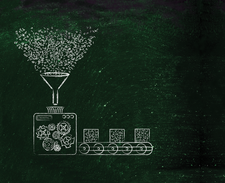Scraping the web for data
Data Harvesting

© Lead Image © faithie, 123RF.com
Web scraping lets you automatically download and extract data from websites to build your own database. With a simple scraping script, you can harvest information from the web.
If you are looking to collect data from the Internet for a personal database, your first stop is often a Google search. However, a search for mortgage rates can (in theory) return dozens of pages full of relevant images and data, as well as a lot of irrelevant content. You could visit every web page pulled up by your search and cut and paste the relevant data into your database. Or you could use a web scraper to automatically download and extract raw data from the web pages and reformat it into a table, graph, or spreadsheet on your computer.
Not just big data professionals, but also small business owners, teachers, students, shoppers, or just curious people can use web scraping to do all manner of tasks from researching a PhD thesis to creating a database of local doctors to comparing prices for online shopping. Unless you need to do really complicated stuff with super-optimized performance, web scraping is relatively easy. In this article, I'll show you how web scraping works with some practical examples that use the open source tool Beautiful Soup.
Caveats
Web scraping does have its limits. First, you have to start off with a well-crafted search engine query; web scraping can't replace the initial search. To protect their business and observe legal constraints, search engines deploy anti-scraping features; overcoming them is not worth the time of the occasional web scraper. Instead, Web scraping shines (and is irreplaceable) after you have completed your web search.
[...]
Buy this article as PDF
(incl. VAT)
Buy Linux Magazine
Subscribe to our Linux Newsletters
Find Linux and Open Source Jobs
Subscribe to our ADMIN Newsletters
Support Our Work
Linux Magazine content is made possible with support from readers like you. Please consider contributing when you’ve found an article to be beneficial.

News
-
Say Goodbye to Middle-Mouse Paste
Both Gnome and Firefox have proposed getting rid of a long-time favorite Linux feature.
-
Manjaro 26.0 Primary Desktop Environments Default to Wayland
If you want to stick with X.Org, you'll be limited to the desktop environments you can choose.
-
Mozilla Plans to AI-ify Firefox
With a new CEO in control, Mozilla is doubling down on a strategy of trust, all the while leaning into AI.
-
Gnome Says No to AI-Generated Extensions
If you're a developer wanting to create a new Gnome extension, you'd best set aside that AI code generator, because the extension team will have none of that.
-
Parrot OS Switches to KDE Plasma Desktop
Yet another distro is making the move to the KDE Plasma desktop.
-
TUXEDO Announces Gemini 17
TUXEDO Computers has released the fourth generation of its Gemini laptop with plenty of updates.
-
Two New Distros Adopt Enlightenment
MX Moksha and AV Linux 25 join ranks with Bodhi Linux and embrace the Enlightenment desktop.
-
Solus Linux 4.8 Removes Python 2
Solus Linux 4.8 has been released with the latest Linux kernel, updated desktops, and a key removal.
-
Zorin OS 18 Hits over a Million Downloads
If you doubt Linux isn't gaining popularity, you only have to look at Zorin OS's download numbers.
-
TUXEDO Computers Scraps Snapdragon X1E-Based Laptop
Due to issues with a Snapdragon CPU, TUXEDO Computers has cancelled its plans to release a laptop based on this elite hardware.

